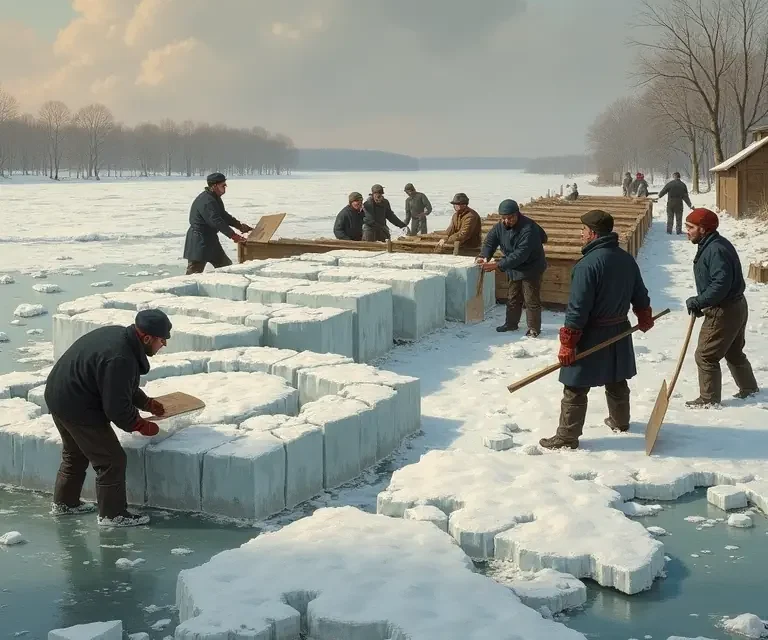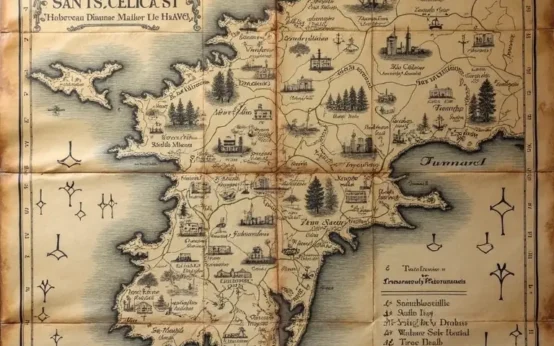For many of us, ice is a simple convenience – a cube dropped into a drink, a necessity for keeping food fresh. But before the advent of modern refrigeration, ice was a luxury commodity, painstakingly harvested from frozen lakes and ponds during the winter months and shipped across the globe. This wasn’t a haphazard undertaking; it was a remarkably sophisticated industry built upon a surprisingly consistent understanding of physics, engineering, and logistics. This article delves into the fascinating science behind historical ice harvesting, exploring its evolution, the techniques employed, and the impact it had on commerce and preservation.
The Pre-Refrigeration World: A Thirst for Cold
Before the 19th century, cooling was limited to natural methods. People used cellars, springhouses, and evaporative cooling techniques to keep food and drinks marginally cooler. But true preservation of perishable goods – meat, fish, dairy – was a significant challenge. The wealthy might have access to snow brought down from mountains, but this was unreliable and expensive. The demand for a reliable source of cold was growing, particularly with increasing urbanization and a burgeoning middle class.
The Birth of an Industry: Frederic Tudor and the Ice Trade
The modern ice trade is largely attributed to Frederic Tudor, a Boston merchant who, in 1806, boldly proposed shipping ice from New England to the Caribbean. This idea was initially met with skepticism – the logistics seemed insurmountable, and the financial risk enormous. However, Tudor persevered, and after several failed attempts, successfully demonstrated the viability of the trade. He recognized that New England’s cold winters and relatively clean ice presented a unique opportunity.
Tudor’s early challenges weren’t just logistical; they were scientific. He needed to understand how to insulate the ice during transport to minimize melting. He experimented with sawdust, one of the most effective and readily available insulators of the time. The key was to slow down the rate of heat transfer, and sawdust proved remarkably effective at creating an insulating barrier. This simple application of thermal physics was foundational to the entire industry.
The Science of Ice Harvesting: More Than Just Cutting Blocks
Ice harvesting wasn’t simply about chopping up frozen water. It was a multi-stage process requiring careful planning and a good understanding of ice formation and its properties. Here’s a breakdown of the key scientific principles involved:
- Ice Formation and Quality: Not all ice is created equal. The clearest, densest ice – formed from slowly freezing, pure water – was the most valuable. Ice formed during a rapid freeze tended to be cloudy and brittle due to trapped air bubbles and impurities. Harvesters sought out lakes and ponds known for producing high-quality ice.
- Timing is Everything: Harvesting occurred in January and February, when the ice reached a sufficient thickness – typically 12 to 18 inches. The timing was critical; waiting too long increased the risk of thawing, while harvesting too early meant the ice wasn’t strong enough to support the weight of men and machinery.
- Cutting the Ice: Initially, ice was cut by hand using long saws. As the industry grew, more efficient tools were developed. Specialized horse-drawn ice plows were used to score the ice into large squares, and then ice harvesters used picks and saws to cut the blocks free. The size of the blocks was standardized to optimize loading and transport.
- Insulation: As mentioned earlier, insulation was paramount. Ice blocks were packed tightly together in the holds of ships, and then completely surrounded by layers of sawdust. The sawdust trapped air, creating a barrier that significantly reduced heat transfer. The thickness of the sawdust insulation was carefully calculated based on the length of the journey and the expected ambient temperatures.
- The Physics of Melting: Understanding the heat of fusion (the energy required to change ice to water) was crucial. Harvesters knew that even with insulation, some melting was inevitable. They aimed to minimize the melt rate to ensure a sufficient quantity of ice arrived at its destination.
Tools and Technology: From Hand Saws to Ice Machines
The ice harvesting industry spurred innovation in tools and machinery. While the earliest efforts relied on manual labor, the demand for increased efficiency led to the development of specialized equipment:
- Ice Ploughs: These horse-drawn plows created a grid pattern on the ice surface, making it easier to cut blocks.
- Ice Harvesting Saws: Long, specialized saws were designed for cutting through thick ice efficiently.
- Ice Hooks and Tongs: Used to move and load the heavy ice blocks.
- Ice Houses: Large, insulated structures built near ice ponds to store ice during the warmer months. These structures were often built partially underground to take advantage of the earth’s natural insulation.
- Steam-Powered Ice Machines (Later): Towards the end of the 19th century, the first mechanical ice-making machines began to appear, offering a more controlled and reliable source of ice, eventually leading to the decline of the natural ice trade.
The development of these tools wasn’t accidental; it was driven by a pragmatic need to apply engineering principles to overcome the challenges of harvesting and handling ice. The design of the ice hooks, for example, considered the optimal angle and leverage needed to lift heavy blocks safely and efficiently.
Logistics and Transportation: A Global Network
Shipping ice across vast distances was a logistical marvel. It required a well-coordinated network of ice ponds, ice houses, ships, and distribution centers. The ice trade wasn’t limited to the Caribbean; ice was shipped to South America, India, Australia, and even China.
The ships used for ice transport were specifically designed to maximize insulation and minimize damage. The holds were tightly packed with ice and surrounded by thick layers of sawdust. Captains and crews were trained to monitor the ice’s condition during the voyage and replenish the sawdust insulation as needed. The success of the trade depended on careful route planning and a deep understanding of weather patterns.

The Social and Economic Impact
The ice trade had a profound impact on society and the economy. It revolutionized food preservation, allowing perishable goods to be transported and consumed over longer distances. This led to changes in diet and eating habits, particularly in urban areas. The availability of ice also spurred the growth of the ice cream industry and other frozen food products.
The industry provided employment for thousands of people, particularly in New England and along the shipping routes. However, it also had a negative impact on the environment. The removal of ice from lakes and ponds altered aquatic ecosystems, and the deforestation required to provide sawdust for insulation contributed to habitat loss. The industry also relied heavily on the labor of immigrants, often under harsh conditions.
The Decline of the Ice Trade and the Rise of Artificial Refrigeration
The ice trade flourished for nearly a century, but its dominance began to wane in the late 19th century with the invention of artificial refrigeration. Carl von Linde’s ammonia compression refrigeration system, patented in 1876, provided a reliable and cost-effective way to produce ice locally. As mechanical refrigeration became more widespread, the demand for natural ice declined rapidly.
By the early 20th century, the natural ice trade was largely a thing of the past. While a few ice harvesting operations continued for a short time, they couldn’t compete with the convenience and efficiency of artificial refrigeration.
A Legacy of Innovation
Despite its eventual decline, the historical ice trade left a lasting legacy. It demonstrated the power of ingenuity, the importance of understanding scientific principles, and the potential for global commerce. The techniques developed by ice harvesters and shippers laid the groundwork for modern cold chain logistics, which are essential for the safe transport of food and pharmaceuticals around the world. It also provides a fascinating case study in how a seemingly simple commodity could drive innovation and shape society.
The story of ice harvesting also reminds us that even seemingly primitive technologies often incorporate a surprising degree of scientific understanding. The successful ice trade wasn’t a matter of luck; it was a result of careful observation, experimentation, and a pragmatic application of physics and engineering.
Further Exploration: Consistent Science Throughout History
The consistent application of scientific principles isn’t unique to ice harvesting. Throughout history, seemingly simple crafts and trades have relied on a deep understanding of the natural world. For example, consider:
- Historical recipe measurements, which, despite appearing imprecise, were often based on consistent ratios and volumes.
- The design and functionality of buttonhooks, which were optimized for leverage and ease of use.
- The intricate mechanisms of vintage sewing machines, a testament to precision engineering.
- The design of historical candle snuffers, carefully crafted to extinguish flames without creating smoke.
- The science behind antique barometers, used to accurately predict weather patterns by measuring atmospheric pressure.
These examples demonstrate that scientific thinking wasn’t confined to laboratories and academic institutions; it was embedded in the everyday practices of artisans and entrepreneurs throughout history.


 The Curious Acoustics of Historical Echo Chambers: Resonance, Ritual, and Revelation
The Curious Acoustics of Historical Echo Chambers: Resonance, Ritual, and Revelation  The Curious Cartography of Scent: Mapping Perfume Ingredients Through History
The Curious Cartography of Scent: Mapping Perfume Ingredients Through History  The Curious Lexicon of Lost Trades
The Curious Lexicon of Lost Trades  The Unexpectedly Consistent Science of Historical Buttonhooks – Fashion, Function & Forgotten Tools
The Unexpectedly Consistent Science of Historical Buttonhooks – Fashion, Function & Forgotten Tools  The Surprisingly Consistent Science of Historical Toy Soldiers – Miniature Warfare, Materials & Collective Play
The Surprisingly Consistent Science of Historical Toy Soldiers – Miniature Warfare, Materials & Collective Play  The Surprisingly Consistent Etymology of Place Names – Uncovering Stories in Street & Town Origins
The Surprisingly Consistent Etymology of Place Names – Uncovering Stories in Street & Town Origins